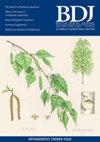Augmented reality: a digital transformation tool to enhance the patient consent process in oral surgery
IF 2.3
4区 医学
Q2 DENTISTRY, ORAL SURGERY & MEDICINE
引用次数: 0
Abstract
Introduction Healthcare literacy within medicine and dentistry is of paramount importance in the modern age. Patients find increasingly novel ways to comprehend and exercise their autonomy with healthcare choices. With the turn of the century, the evolution of the digital world has led to an open forum of resources for patients and healthcare professionals alike. Methods At the Royal National ENT and Eastman Dental Hospitals, a team of clinicians sought to explore the use of augmented reality in the patient consent process for oral surgery. Patients completed a two-part health literacy questionnaire based on their understanding of cone beam computed tomography (CBCT) and a patient-specific holographic image created using Microsoft HoloLens augmented reality technology. Results In total, 28 patients participated voluntarily in the study: 96% patients (n = 27) stated their preference for the holographic image when asked whether CBCT images or HoloLens images were more user-friendly, and 27 patients strongly agreed (Likert score = 7) that the holographic image improved their confidence in decision-making. Conclusion Augmented reality has the potential to change the way healthcare information is conveyed to patients in the 21st century. This study demonstrates how holographic imaging can be used as an adjunct to communicate with patients, improve the consent process and enhance healthcare literacy.

增强现实:提高口腔手术患者同意过程的数字转换工具。
在医学和牙科保健素养在现代是至关重要的。患者发现越来越多的新方法来理解和行使他们在医疗保健选择方面的自主权。随着世纪之交,数字世界的发展为患者和医疗保健专业人员提供了一个开放的资源论坛。方法在皇家国家耳鼻喉科和伊士曼牙科医院,一组临床医生试图探索在口腔手术患者同意过程中使用增强现实技术。患者根据他们对锥束计算机断层扫描(CBCT)的理解和使用微软HoloLens增强现实技术创建的患者特定全息图像完成了两部分健康素养问卷。结果共有28名患者自愿参与研究,当被问及CBCT图像或HoloLens图像是否更方便使用时,96%的患者(n = 27)表示更喜欢全息图像,27名患者强烈同意全息图像提高了他们的决策信心(Likert评分= 7)。结论在21世纪,增强现实技术有可能改变医疗信息传递给患者的方式。本研究展示了全息成像如何被用作与患者沟通的辅助手段,改善同意过程并提高医疗保健素养。
本文章由计算机程序翻译,如有差异,请以英文原文为准。
求助全文
约1分钟内获得全文
求助全文
来源期刊

British Dental Journal
医学-牙科与口腔外科
CiteScore
3.10
自引率
15.40%
发文量
1096
审稿时长
4-8 weeks
期刊介绍:
The role of the BDJ is to inform its readers of ideas, opinions, developments and key issues in dentistry - clinical, practical and scientific - stimulating interest, debate and discussion amongst dentists of all disciplines. All papers published in the BDJ are subject to rigorous peer review.
 求助内容:
求助内容: 应助结果提醒方式:
应助结果提醒方式:


